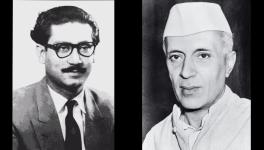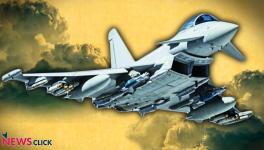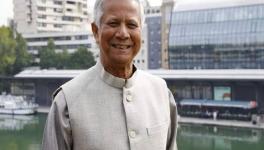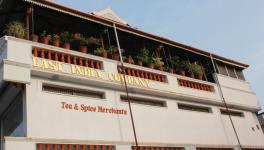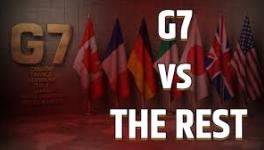Aero-Engines: Will the French Connection be a Game-Changer?
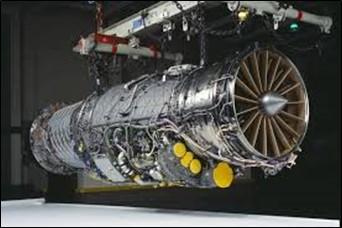
GE F-414 Engine.
In the past few weeks, during exchange visits to India and France by security officials, France has seriously upped the ante on its competitors regarding provision of advanced defence hardware and, more importantly, technology transfer to India. The new French offers come at a time when the US is making big strides compared with its earlier hesitation in offering sophisticated defence equipment with technology transfer, seeking to cement its place as a dominant player in the Indian defence scenario.
The Backdrop
Coincidentally or otherwise, the latest French moves have been made against the backdrop of some recent rumblings of discontent in the Indian military, the strategic community and defence commentators about delays, shortfalls or hesitation in military hardware sales, especially related to technology transfer.
The deal for 31 armed Predator high-altitude drones appeared to be taking forever, till the Cabinet in India put its stamp on the deal. Voices are being heard wondering, as does this writer, if India should take this opportunity to review the Predator acquisition in view of the apparently easy shooting down of several Predators over Yemen by the Houthis, not exactly known to be among the best-armed groups. Predator drones are designed and equipped for operations in uncontested airspace, and neither of India’s land border areas can be described that way.
The delivery of well over 200 General Electric F-404 engines for the Tejas Mk1A fighters have also been inordinately delayed, because of supply chain problems, including some emanating from sanctions against Russia, resulting in the inability of Hindustan Aeronautics Ltd (HAL) to deliver the fighters to the Indian Air Force (IAF) on schedule. This required a strong push by the Indian Defence Minister during a recent visit to Washington. Many are even wondering whether the delay is deliberate to underline India’s dependence on the US, highlighting the well-known unreliability of the US as a defence partner.
Nevertheless, the US, meanwhile, clinched a major deal with India to supply initially 99 advanced and more powerful GE-F414 engines for the Tejas Mk2 fighter. The order could potentially be much larger if the numbers of Tejas Mk2 fighters inducted by the IAF gets much larger and if the F-414 engine is also adopted in other future Tejas variants.
Indeed, fears have also been expressed that the large GE deal, likely to power the Tejas fighters well into the next decade, may strike a fatal blow to indigenous efforts to develop an engine. The GE deal includes significant technology transfer and manufacture of the engine by HAL in India, an unprecedented step by the US in recognition of India’s desire for indigenisation of technologies, and, of course, the US desire to raise its share of the sizeable Indian defence market. GE has reportedly raised the indigenous content from an earlier 60% to 80%, involving critical advanced technologies as discussed later.
Noteworthy Offers
In this context, France has recently made two very significant offers to India. The first, and the focus of this article, is to co-design, develop and manufacture with Indian partners a completely new powerful and advanced aircraft engine with full technology transfer and significant proprietary rights.
The second, and equally important offer, which will be discussed only in a subsequent article, is to co-produce a nuclear-powered attack submarine with technology transfer. Other offers were made too, such as for autonomous vehicles in air, surface and under-sea operations with full-spectrum surveillance capabilities.
France has long been an important supplier of defence equipment to India going back to the early post-Independence era, and continuing through India’s early space programme. France has assisted with rocket engines from Safran, fighter jets from the Mystere onward, a multi-platform military helicopter licensed production programme for the Alouette/ Chetak/Cheetah, and the on-going supply of Rafale fighters along with a recent deal to supply naval Rafales for India’s aircraft carriers, beating the US Boeing F/A-18 in the tender.
This has served the geo-political interests of both countries. France has developed and promoted its cherished independent military capability, trade and global strategic relationships, separate from those under the Anglo-American alliance, while India has developed its own defence and geo-political relationship with France as a strong demonstrator of its strategic autonomy, vis-à-vis the former colonial power in the early post-independence years and latterly from the Anglo-American axis.
The latest French overtures come with an added geo-political edge. In 2021, Australia pulled out of a signed deal with France to build 12 Naval Group (former DCNS) diesel submarines (that could later be switched to nuclear power) in Australia at a cost of Euro 50 billion. While various reasons were advanced for the termination, what really angered the French was that the US, the UK and Australia almost immediately signed a deal to make Anglo-American nuclear powered submarines invoking the AUKUS defence pact.
Any Indo-French nuclear submarine deal is still distant, given India’s own indigenous nuclear submarine programme under which two subs have already been commissioned, two more are under construction and another two approved at the recent Cabinet meeting.
In terms of technology, the French offer to co-develop a new engine with India has special importance and the issues raised underlines what true scientific and technological self-reliance is all about.
Modern Military Jet Engines
One often hears the phrase “it’s not rocket science” to suggest that an idea is quite simple and is certainly not the peak of complexity as signified by rocketry. Although the phrase does not sound so good, it should really be “it’s not aero-engine technology.”
Aero engines are actually far more difficult to design and manufacture, and has many more elements, components, varying operational conditions and aspects requiring to be controlled than rockets do. Many countries and companies design or manufacture aircraft, but only a tiny handful makes aero-engines especially for modern jets.
Briefly, to understand the issues, typical aero-engines have a compressor section, a combustion chamber and a turbine section. The compressor, which could have several stages, is a set of rings with aerofoil blades arranged around the ring like spokes, which compress incoming air increasing its pressure and velocity. This air enters the combustion chamber where fuel is added and lit, heating the air to high temperatures. This hot air then passes through the turbine, sort of a compressor in reverse, where it is expanded, cooled and slowed down, in the process generating electro-mechanical power to drive the whole system, and finally released through a nozzle generating thrust to propel the aircraft forward.
According to laws of thermodynamics, the greater the difference in temperature between compressor entry and turbine exit, the greater the efficiency of the system, that is, the higher the amount of energy extracted compared with the energy put in.
Similarly for the nozzle. (In a gas turbine, such as in power generation equipment, the thrust generated at the exhaust is irrelevant, so all efforts focus on extracting useful mechanical energy from the turbine). In modern fighters, an afterburner adds more fuel to the exhausted air, heats and speeds it up even further to generate substantial additional power required, for instance, during short or fast take-off, supersonic flight or sudden bursts of power during aerial combat.
As jet aircraft modernised, and demands for power, speed, ability to lift loads, ability to perform under different operational conditions, demands on the engine increased. Further demands such as fuel efficiency, exhaust pollution and emissions, noise control have also been added to the mix. An engine should, therefore, be able to operate at different speeds, altitudes, hot and cold conditions, and so on.
Military fighter aircraft have enormous additional requirements. Engines are required to generate and cope with high speeds, angles of operations, large variations in altitude and speed, and most important ability to respond quickly to commands by the pilot. The compressor and turbine, the crucial moving parts, should therefore be able to withstand huge mechanical stresses which can cause the metal components to lose shape, performance and longevity. The turbine imposes additional stresses due to high heat and operating temperatures. Over the years, turbine temperatures have reached new highs.
All these have brought greater complexity to both design and manufacture of aero-engines. The aerofoil shapes for compressor and turbine are now engineered for maximum performance through sophisticated design processes and simulations. Manufacturing these blades with complex geometries has also become more complicated.
Turbines are nowadays operating at temperatures of around 1800 degrees Celsius or more, to give an idea close to the boiling point of molten silver. Turbine blades must be able to withstand these temperatures, withstand mechanical stresses due to high rotational forces, resist processes of creep (tendency to lose shape over time) and fatigue (cracks or other failures due to prolonged high-performance use), and also deliver performance over extended durations. These call for special materials.
For high temperature turbines, highly specialised materials called superalloys, usually containing variants of high melting point nickel, optimised for light weight and high temperature, high-stress operations have been developed over the years. Making these materials and manufacturing the complex shapes required have become the frontier of science and technology in aero-engines, calling for specialised knowledge, skills and machinery which very few countries or companies have.
Significance of Safran Offer for India
GE’s F-414 engines contain many if not all these above modern jet engine technologies. It is understood that the indigenisation component likely to be involved in the transfer of technology (ToT) transfer by GE to its Indian partner, HAL and numerous sub-contractors, is believed to have been raised to 80%, including so-called hot section components, such as the combustion chamber and turbines involved in advanced materials and manufacturing.
However, it is believed that this ToT is confined to licensed manufacture and may not include know-how critical for development of materials and manufacturing techniques. GE will also retain all intellectual property (IP) and there will also be restrictions on numbers manufactured, export and even adaptation or improvement.
Safran, on the other hand, is understood to have included development of materials and manufacturing techniques, with special attention to training Indian engineers in advanced materials know-how and manufacturing. Safran is also believed to have agreed to give its Indian partner full control over IP including for upgrading, adaptation and export.
High performance aero-engines use what is known as single crystal turbine blades, a prized know-how and manufacturing technology. In the 1960s, scientists and engineers discovered that when these advanced alloys were cast, they formed crystalline structures as they cooled down from molten states. These crystals were oriented differently and formed boundaries between each other, which could lead to development of faults. Teams from Universities moved over to and joined those at aero-engine major Pratt & Whitney, and developed suitable alloys and casting techniques to yield single-crystal turbine blades, that is whole turbine blades made from a single crystal, eliminating crystal boundaries altogether. The team brought basic and applied research to manufacturing in a relatively short period of around 10 years.
Advanced materials have been a major knowledge and capability gap in India, and this has also had impact on aero-engine development. If India acquires this know-how, and absorbs the research and development processes into its academic and industrial research ecosystem, it could catapult India into the front ranks of the aviation industry.
There are, of course, significant question marks on India’s ability to absorb the know-how and use it creatively in developing materials for other applications, but this would be an important first step toward it. Manufacturing techniques alone, without the knowledge behind them, are inadequate for this purpose. It should be remembered that India has been license-manufacturing many aircraft from the West and from the former Soviet Union over seven decades but has been unable to absorb know how for design-development of aero-engines.
DRDO’s (Defence Research & Development Organisation) efforts at developing an indigenous aero-engine has been floundering for close to two decades. Early efforts to develop an engine for the Tejas LCA collapsed, and LCA development had to proceed on imported GE F-404 engines. Further development of the Kaveri engine also came to an abrupt halt after failure during high-altitude tests in Russia. Now this engine is said to be used for UAVs and at present nobody knows if that will work.
The Safran offer is very promising and deserves serious consideration. Contradictory though it may seem, this collaboration may be an important first step towards self-reliance further down the road.
The writer is with the Delhi Science Forum and All India People’s Science Network. The views are personal.
Get the latest reports & analysis with people's perspective on Protests, movements & deep analytical videos, discussions of the current affairs in your Telegram app. Subscribe to NewsClick's Telegram channel & get Real-Time updates on stories, as they get published on our website.









